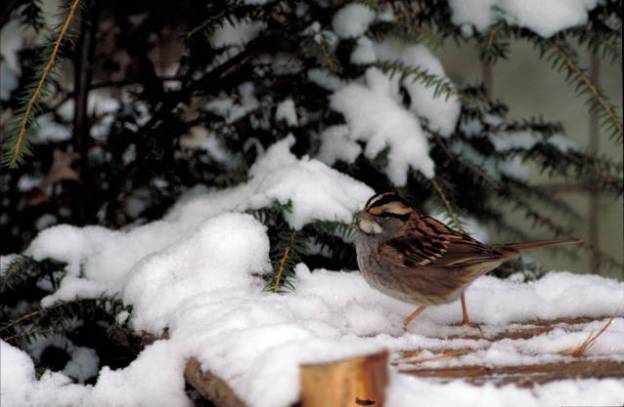
Photo by Pixabay.com • A yellow dot on the white-throated sparrow’s lores, a region on the face between the bill and the eyes, is one easy means of distinguishing the winter bird from its fellow sparrows, a family often dismissed as “little brown birds.”
Winter’s a season painted in shades of gray. Or brown, in the case of some of the “little brown birds” known as sparrows that enliven our yards and gardens during the colder months. A few, like the song sparrow, reside near us through all the seasons, but most of the sparrows are visitors only during the colder months of the year. This diverse family includes such birds as dark-eyed junco, chipping sparrow, white-throated sparrow, white-crowned sparrow, field sparrow, fox sparrow, and Eastern towhee.
I host many of these sparrows every winter, but one of the most reliable visitors is the white-throated sparrow. The white-throated sparrow and the closely related white-crowned sparrow both belong to a genus of American sparrows known as Zonotrichia, which includes three other species. The other three — golden-crowned sparrow, rufous-collared sparrow, and Harris’s sparrow — range mostly outside the continental United States. The rufous-collared sparrow ranges throughout Mexico, as well as the island of Hispaniola. Harris’s sparrow is a bird that occurs mostly in Canada, although there are a handful of records in our region. The golden-crowned sparrow is a bird that occurs mostly in Alaska, although some of this sparrow’s population ranges into the northwestern corner of the state of Washington.

Photo by Skeeze/Pixabay • A white-throated sparrow perches on a branch to sing its easily recognizable song. Many Americans translate the sparrow’s song as “Ol’ Sam Peabody, Peabody, Peabody.”
The genus name, Zonotrichia, refers to two ancient Greek words for zone and hair, which refers to the pattern of streaks on the backs of these five sparrow species. The Zonotrichia sparrows belong to a large group of birds known as Passerellidae, or American sparrows, which also includes birds such as juncos, towhees and brush finches. Some of the more descriptive names for American sparrows include orange-billed sparrow, white-eared ground sparrow, green-backed sparrow, olive sparrow, cinnamon-tailed sparrow, five-striped sparrow and golden-winged sparrow.
Many sparrows, including the white-throated sparrow, prefer to forage for food on the ground. It’s often helpful to purchase a supply of millet seed. When filling feeders with sunflower seeds, scatter a couple of handfuls of millet seed on the ground beneath the feeders or at the edge of a brushy area. Sparrows like to have quick access to dense cover, so they will feed more securely if the scattered seeds are within quick reach of shelter.

Photo by Skeeze/Pixabay • A white-throated sparrow perches on a branch to sing its easily recognizable song. Many Americans translate the sparrow’s song as “Ol’ Sam Peabody, Peabody, Peabody.”
In fact, food and shelter are probably the two most compelling factors sparrows take note of when selecting a yard for their winter residence. There are easy means of providing the shelter that gives these small birds peace of mind. Leave an edge or corner of your yard in a unkempt manner. Don’t cut down grass, weeds, and saplings. Even if human neighbors look askance, your feathered friends will be grateful. An alternative is to create a brush pile with discarded trimmings taken during periodic spruce-ups of the yard and garden. Sparrows, as well as other birds, will use the brushy cover as a shelter from the elements and as protection from visiting raptors such as sharp-shinned hawks.
The white-throated sparrow is so named for the patch of white feathers on the throat. While this field mark help with identification, there are other distinct features of this particular sparrow that helps contrast it from members of the “little brown bird” gang. For starters, adults have a bold face pattern of black and white crown stripes. The most obvious field mark for attentive observers is the yellow spot between the eye and the bill. It’s a vivid splash of color not commonly found in the plumage of most of its kin.
Most songbirds live a precarious life that can be measured in only a few years. However, an occasional individual defies the odds. According to the website allaboutbirds.com, the oldest recorded white-throated sparrow was at least 14 years, 11 months old, when it was recaptured and rereleased during banding operations in Alberta, Canada.
Although they are fairly common winter visitors in the region, the white-throated sparrow makes its presence known most strongly each spring when the birds begin to sing a familiar refrain that has been transcribed in a couple of different ways. Many Americans render the song of the white-throated sparrow as “Ol’ Sam Peabody, Peabody, Peabody.” For those living north of the border, the white-throated sparrow sings “O’Canada, O’Canada, O’Canada.” No matter how you translate this sparrow’s song, it’s a sweet and welcome addition to the spring aural landscape.
Most white-throated sparrows depart the region by late April to reach their summer nesting grounds throughout the forests across Canada, the northeastern U.S. and the northern Midwest. In the influx of more showy birds each spring, their absence sometimes goes unnoticed. Nevertheless, it always feels good to welcome them when they return in late October and early November as winter begins extending its grip for the season.
Share your own sightings. Email me at ahoodedwarbler@aol.com with observations, comments or questions.


